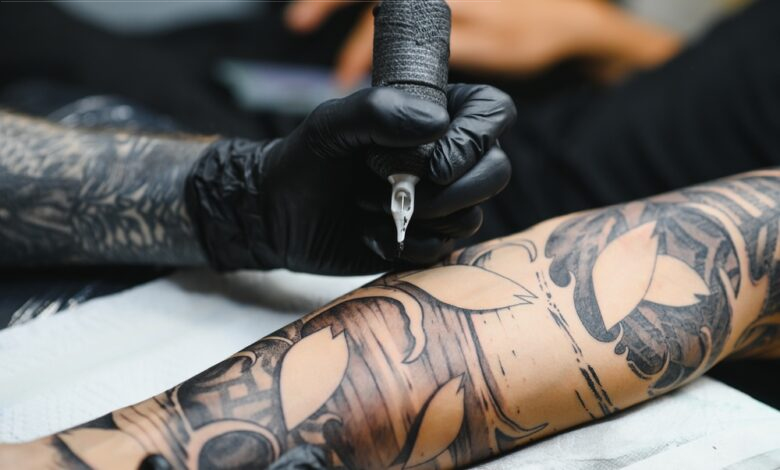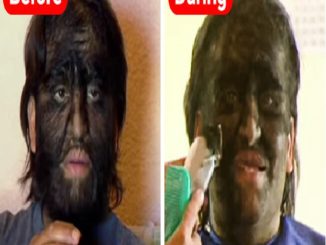
Older generations used to warn that people shouldn’t get tattoos because they’re permanent and someone may one day regret getting them. However, these days tattoo removal is an option. Although painful, it works after a few sessions but can leave behind some scarring. Either way, 35-year-old Leandro De Souza has decided to undergo laser treatments to remove almost 2 decades worth of ink.

Leandro De Souza is a native of Brazil and a proud father. However, his divorce almost a decade ago proved to be almost more than he could handle. As a result, De Souza went down a path of partying. During this time he accumulated more than 170 tattoos but his first ink was at just 13 years old. “I did the first one when I was 13,” De Souza explained. “The first ones were very much about the idolatry of the time.” However, he’s recently set out on a religious path of Evangelicalism. As a result, he’s decided to undergo the laser tattoo removal process.
Facing Heartbreak

Leandro’s first tattoos were inspired by his favorite bands, such as Nirvana, Guns N’ Roses, and Metallica. However, the majority of his tattoos were from a decade-long binge following his divorce. During that time, Leandro admittedly experimented with drugs like LSD, alcohol, and ecstasy.
Finding Motivation for Tattoo Removal

“I couldn’t stand the life I was living anymore. I was an attraction at (events I attended) and it felt like a circus animal.” He said regarding his decision for tattoo removal. De Souza was visiting a shelter almost a decade after his difficult divorce. This visit would change the course of his life. “The first step in everything in life is to accept that you can’t do it alone, that you are an addict, that you are a drug addict,” de Souza said. “And I managed to do that, I entered the municipal shelter in Bagé. Within a week, there was a lady who referred me and started to evangelize me.“
Turning a New Leaf

It’s been 2 years since De Souza changed his life and opted for tattoo removal. However, it’s a long process that will be more so for De Souza’s 170 tattoos. Moreover, he now spends his time speaking with “parents and children in homes that are in prisons.”
Leandro began the tattoo removal process with the help of a tattoo studio in Franco da Rocha, São Paulo, which heard about the exciting changes Leandro was making to turn his life around. He’s now been clean from alcohol for 3 years, and free of tobacco and other substances for a year. De Souza still has 6 more tattoo removal sessions before his ink is gone and his transformation, so far, is astonishing and awe-inspiring.
Tattoo Removal is a Modern Possibility

For many, getting a tattoo is inspired by the desire to express one’s creativity, treating their body like a canvas. However, others may regret their ink choices as they mature or their interests and relationship status change. Fortunately, tattoo removal is possible with advancing technology but there are a few side effects like tenderness, skin irritability, and even scarring.
Tattoo Removal Methods

Interestingly, tattoo removal comes with options. De Souza’s treatment, laser tattoo removal, uses lasers to “heat the ink particles,” breaking them down and making it “easier for your immune system to remove,” according to Cleveland Clinic. Laser tattoo removal sessions are scheduled about 3 months apart and can last anywhere from 30 minutes to an hour depending on the size of the ink. This method does come with side effects that range from mild skin irritation to painful blisters, but each person responds differently to treatment.
Skin Removal for Tattoo Removal

Another option for tattoo removal is surgical excision. The medical procedure requires a surgeon, who will “cut out the skin that contains a tattoo.” Then they will “stitch your remaining skin together.” The procedure probably sounds intimidating but it’s only used for small tattoos, as cutting an entire back tattoo and then stitching it up would be unpleasant, dangerous, and seemingly impossible.
Meanwhile, dermabrasion and chemical peels are used to remove the outer layers of skin. Unfortunately, both can cause severe skin sensitivity, especially in sunlight. Therefore, understanding the risks and how to treat the skin properly as it heals is essential to your skin’s health and physical comfort.
Not Recommended by Professionals

Lastly, and possibly least popular and effective, are tattoo removal creams. They can be used at home and often take months or years to yield results. Furthermore, they contain acids that “irritate or damage your skin.” As such, they’re usually advised against by medical professionals.
Can Anyone Get Tattoo Removal

In short, yes. However, some things are worth noting when considering tattoo removal. Firstly, tattoo removal takes time and similar or repetitive steps to be effective, regardless of your chosen tattoo removal method. The reason for this is that a tattoo artist applies ink in layers of the skin, so layers have to be broken down which can’t happen in one sitting, otherwise you’ll suffer severe and irreversible skin damage. Ultimately, that would put your overall health and immunity at risk. Additionally, your skin needs time between sessions to “flush out the ink” so, it’s recommended to wait a few weeks or months between most tattoo removal options listed above.
Secondly, certain ink colors are easier to remove than others. For example, blue and black are easy to remove during laser tattoo removal because “they’re better at absorbing light.” Meanwhile, colors like red are difficult to remove because their “molecular composition” is more resistant to the treatment options.
An Alternative

Consider having them turned into something else, rather than removed. For instance, if you’re considering tattoo removal and the reason has nothing to do with necessity, for work, or because, like De Souza, you’re on a new path. Instead, you don’t like how it looks anymore, have separated from the person who inspired the tattoo, or have other interests. In this case, you might consider another visit to the tattoo shop to have them create something else by covering the existing tattoo. For many, this option may be more satisfying and less time-consuming.
Your Future Doctor is Using ChatGPT to Pass Med School, So You Better Start Eating Healthy
We live in a digital age, and technology is quickly reshaping every aspect of our lives, including healthcare. ChatGPT, an advanced AI model, is becoming an indispensable tool for medical students, helping them ace exams and pass medical school. While this might seem like a distant and futuristic phenomenon, it’s happening right now, and it begs the question: How does this impact you as a patient? The answer is simple: The future of healthcare is rapidly evolving, and so should your approach to health, especially when it comes to nutrition.
In this article, we’ll delve into how ChatGPT is transforming medical education, how it could influence the doctors of tomorrow, and why adopting a healthier lifestyle today is more important than ever. Let’s get started!
The Rise of AI in Medical Education: ChatGPT’s Role

Artificial intelligence (AI) has already revolutionized numerous industries, and medicine is no exception. In the past few years, medical students and professionals have started leveraging AI tools like ChatGPT to aid in studying, diagnosing, and even communicating with patients.
Why Medical Students Love ChatGPT
Medical school is notoriously challenging, requiring vast amounts of knowledge to be memorized and applied. For medical students, this is where ChatGPT shines. This AI can quickly generate answers to complex medical questions, assist in case studies, and help students prepare for exams by providing accurate information on a variety of diseases, treatments, and drugs.
With access to vast databases of medical knowledge, ChatGPT helps students review content, explain difficult concepts, and offer a platform to practice clinical reasoning. As a result, it speeds up the learning process and allows students to spend less time on memorization and more time on problem-solving and practical application.
How ChatGPT Enhances Medical Training and Exam Preparation
It’s no secret that passing medical school exams is no small feat. The rigorous exams, including the USMLE (United States Medical Licensing Examination) and other standardized tests, demand a deep understanding of anatomy, pharmacology, pathology, and much more. AI tools like ChatGPT allow students to:
Video : 4 Ways Artificial Intelligence is Transforming Healthcare
- Review Medical Concepts: ChatGPT can help students grasp complex medical concepts by providing clear explanations and answering any questions they might have. Whether it’s clarifying the function of the human circulatory system or offering differential diagnoses for a certain symptom, the AI is always available for students.
- Simulate Case Studies: With the use of AI, students can interact with simulated patients, learning how to make decisions in real-time and understanding what works best in certain clinical scenarios. ChatGPT can help simulate these scenarios, allowing medical students to practice their diagnostic and treatment skills without the need for real-life patients.
- Practice with Mock Exams: ChatGPT can generate mock exam questions, giving students the opportunity to test their knowledge and practice under exam conditions. This preparation is crucial to ensure they are ready for the real thing.
What Does This Mean for You? The Future of Healthcare is AI-Powered
Now, you might be wondering: How does this impact me as a patient? Well, the doctors of tomorrow are already using AI like ChatGPT as a key part of their training. In fact, the next generation of doctors may be more adept at leveraging technology for faster diagnosis, treatment plans, and patient communication.
A More Efficient Healthcare System
Imagine a world where your doctor can quickly analyze medical data, provide the most accurate diagnoses, and suggest optimal treatment plans—all in a matter of minutes. With AI tools like ChatGPT, this scenario is not far from becoming a reality. In fact, AI is already helping healthcare providers in certain areas like imaging, diagnosis, and drug discovery.
Better Communication with Doctors

As AI becomes an integral part of healthcare, doctors will also use tools like ChatGPT to communicate more effectively with their patients. Imagine being able to consult a doctor who can instantly access the latest medical research, provide personalized advice, and guide you through treatment options with ease. The future of healthcare is not just about technology—it’s about improving the patient experience.
How ChatGPT Could Change the Way Doctors Make Decisions
AI models like ChatGPT can support doctors in their decision-making processes by providing them with data-driven insights, recommendations, and even potential alternatives that they might not have considered. While AI can never replace the need for human empathy and judgment, it certainly adds value in terms of offering a broader range of possibilities for treatment.
- Faster Diagnoses: Doctors can access ChatGPT’s database of medical information, enabling them to reach a diagnosis quicker, reducing the chances of error.
- Better Research and Evidence-Based Medicine: ChatGPT can quickly review vast amounts of medical literature and present the most recent findings to doctors, ensuring that their treatment approaches are based on the latest evidence.
The Role of Nutrition: Why Eating Healthy Matters More Than Ever
So, what does all this have to do with you? Well, while the medical field is evolving rapidly, there’s one thing that will always remain at the heart of your health: your lifestyle. Your health is still largely in your hands, and no amount of advanced AI can replace the benefits of a healthy diet.
Video : HOW AI İS SHAPİNG THE FUTURE OF BRAİN SURGERY TRAİNİNG AND EDUCATİON
Doctors, even with the help of cutting-edge technology, will always rely on the foundation of good health: nutrition. But with more and more people relying on processed foods, high sugar intake, and unhealthy habits, this is where the AI-enhanced healthcare system can’t always help.
What You Can Do Today to Improve Your Health
- Eat Whole, Nutrient-Rich Foods: Try to fill your plate with fruits, vegetables, lean proteins, and healthy fats. Avoid processed foods and aim to eat meals that nourish your body.
- Drink Plenty of Water: Hydration is key to maintaining healthy body functions. Drinking water supports digestion, brain function, and circulation.
- Exercise Regularly: Regular physical activity helps prevent chronic diseases, boosts mood, and improves cognitive function.
- Prioritize Sleep: Sleep is just as important as diet and exercise. Make sure you’re getting enough rest to allow your body to repair and rejuvenate.
Conclusion: The Power of a Healthy Lifestyle in the Age of AI
While the future of healthcare may involve AI-enhanced decision-making and quicker, more accurate diagnoses, the foundation of good health will always lie in the choices we make every day. Eating healthy, exercising regularly, and prioritizing rest are still the most effective ways to take care of your body, regardless of the technology that doctors might use.
So, as ChatGPT and other AI tools become a part of the medical landscape, remember that your role in your health is more important than ever. Start making better choices today, and you’ll be able to enjoy a healthier tomorrow—AI-assisted or not.



Leave a Reply